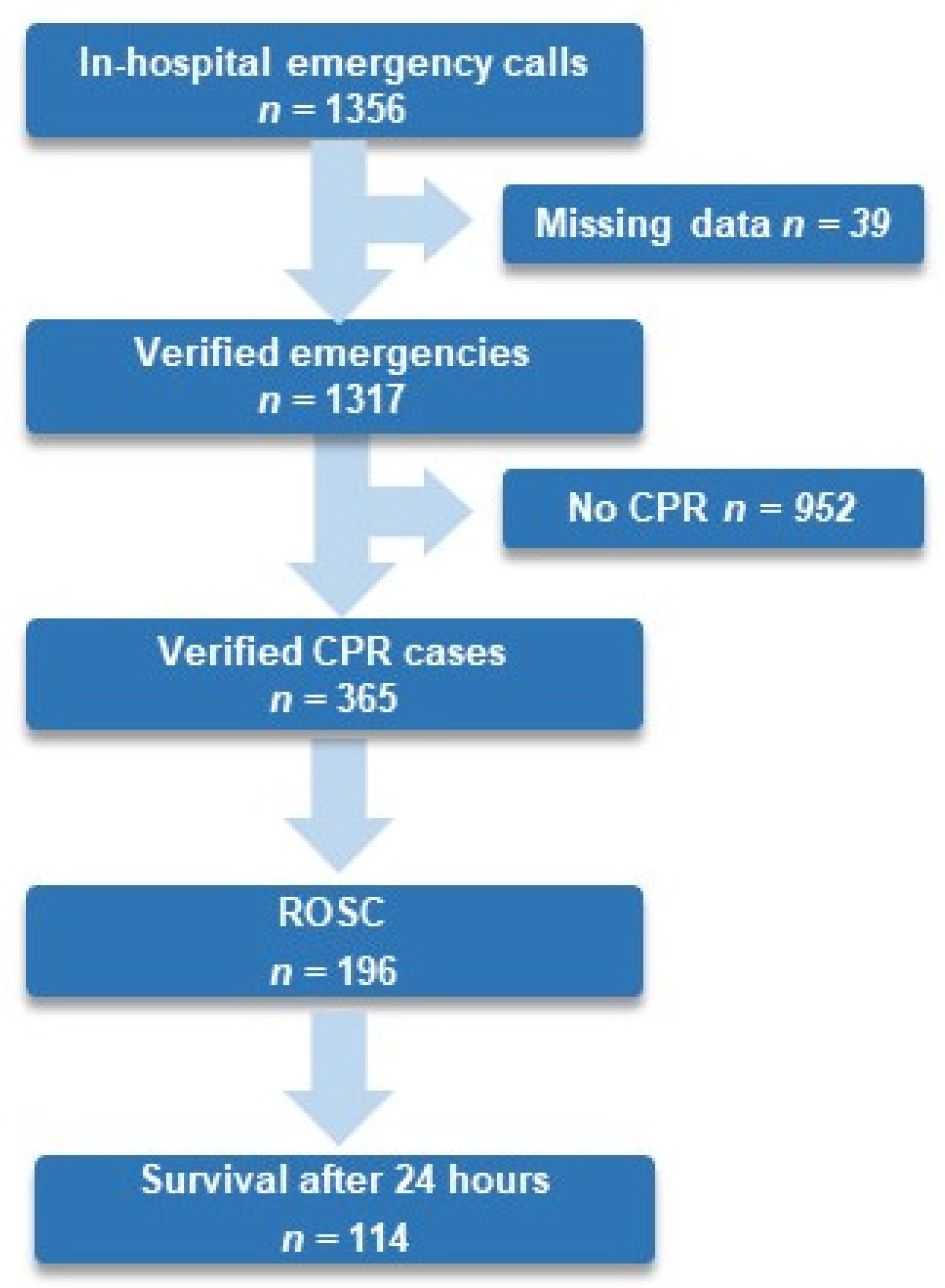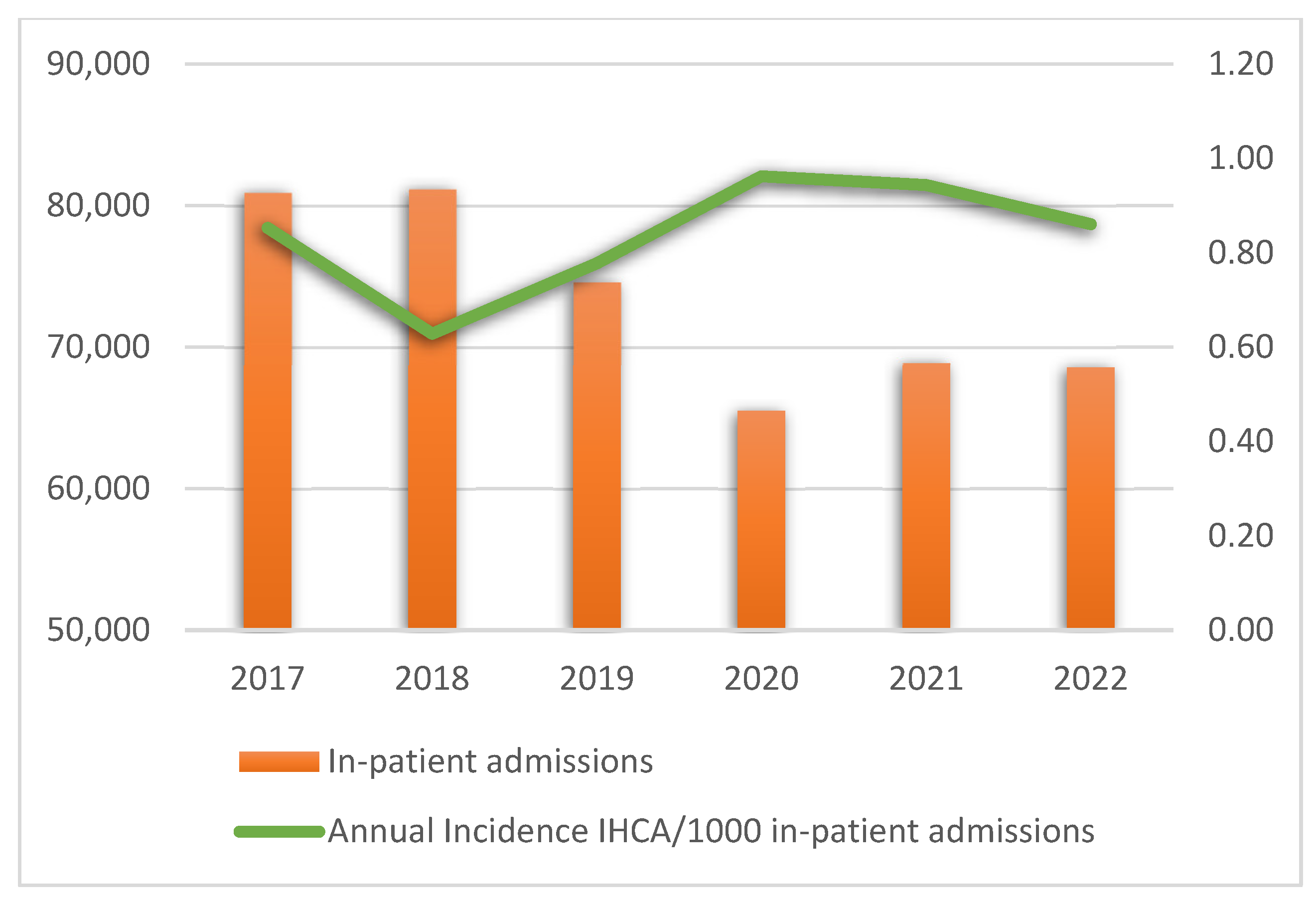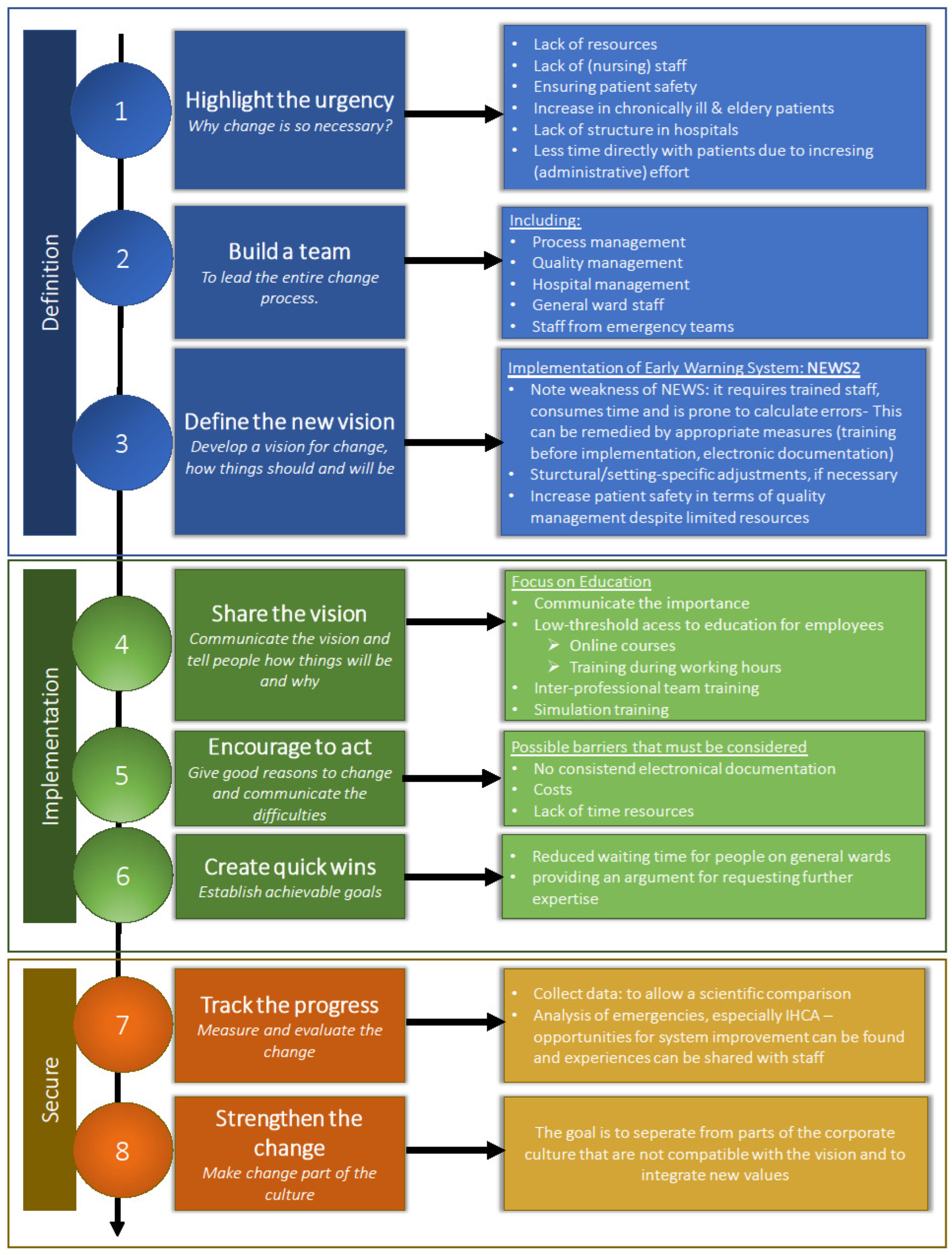Overcoming Barriers in the Introduction of Early Warning Scores for Prevention of In-Hospital Cardiac Arrests in Austrian Medical Centers †
Abstract
1. Introduction
2. Materials and Methods
2.1. Study Design
2.2. Quantitative Methods
2.2.1. Subjects
2.2.2. Collection of Quantative Data
2.2.3. Variable Distribution
2.3. Qualitative Methods
- (1)
- Ninety-three standard hospitals providing basic healthcare services;
- (2)
- Twenty-eight specialized hospitals providing an extended range of medical services beyond basic care;
- (3)
- Seven central hospitals offering comprehensive care 24/7 for acute and complex medical needs.
2.3.1. Selection of Participants
2.3.2. Collection of Qualitative Data
2.3.3. Qualitative Analysis
2.4. Integration of Quantitative and Qualitative Data
2.5. Ethics
3. Results
3.1. Local Data Regarding IHCA in Innsbruck
3.2. Data from the Guided Interviews
3.3. Structure of In-Hospital Emergency Medicine in Austria
“We are operating within that magnitude. Approximately half and half: anesthesiologists and internists.” (interview 1, line 279, consultant lead for in-hospital emergency medicine, board-certified specialist in anesthesiology and intensive care medicine, specialized hospital)
“We have alert criteria, if you want to call them that. These were taken from Hillman’s work around 2000 or 2001. They’ve been tested since 2010 and have been in use since 2012. They’re what you call ‘single track and trigger’ systems.” (interview 4, line 61ff, critical care nurse, in-hospital emergency management coordination unit, central hospital)
3.4. Barriers to the Implementation of EWS
“I think it mainly fails because of nursing staff, simply because there isn’t enough capacity to check on every patient on the general ward once an hour or so. They’re just, probably everywhere, really at their limit.” (interview 9, line 238ff, board-certified specialist in anesthesiology and intensive care medicine, clinical responsibilities in in-hospital emergency medicine, central hospital)
“Another important aspect is the academization of nursing which was certainly not a beneficial development. Experience and clinical intuition remain essential to recognize a deteriorating patient.” (interview 8, line 160ff, head of department of anesthesiology, board-certified specialist in anesthesiology and intensive care medicine, specialized hospital)
“It is important—indeed absolutely essential—that hospital staff possess certain knowledge and skill, especially in an acute care hospital. I believe that for quality assurance reasons, there is no way around maintaining a low-threshold access, and also offering regular training sessions.” (interview 4, line 225ff)
3.5. Best Practice Tutorial
- Innovation domain
“We do not use either MEWS or NEWS. They were temporarily used in one unit, but that happened to be an IMCU ward—essentially an environment for which these scores were neither intended nor designed. Consequently, they are no longer used there.”(interview 2, line 111ff, board-certified specialist in anesthesiology and intensive care medicine, clinical responsibilities in in-hospital emergency medicine, central hospital)
“Nursing staff is glad to have a structured concept in place, so they can say: you need to take care of this patient now because I have documented this value.” (interview 6, line 190ff, physician-in-charge of ICU, board-certified specialist in anesthesiology and intensive care medicine, responsible for the in-hospital emergency team, central hospital)
“Yes, but even the ward physician can be overwhelmed, because nowadays the spectrum of illnesses that patients bring with them is simply much broader.” (interview 10, line 277f, critical care nurse, intermediate care unit, department of orthopedic and trauma surgery, central hospital)
- 2.
- Outer Setting domain
- Process Management
“If people don’t exceed their maximum working hours, they can sign up for as many trainings as they want. That counts as working time, these are the costs.” (interview 5, line 3119ff, head of the emergency department, board-certified specialist in internal medicine, specialized hospital)
- b.
- Quality Management
“We are members of the German Resuscitation Registry. We document our emergencies using a protocol provided by the German Resuscitation Registry. Two of my senior physicians consistently enter the data into the database. We thoroughly review the annual report and implement appropriate measures based on its findings.” (interview 7, line 149ff, head of department of anesthesiology, board-certified specialist in anesthesiology and intensive care medicine, specialized hospital)
- c.
- Hospital Management
“Based on my impression, there would be a willingness to invest a certain amount of money if, an early warning system were to be implemented. This requires training, which incurs costs primarily due to the time spent on duty. I do believe such a willingness exists.” (interview 3, line 200ff, consultant lead for in-hospital emergency medicine, board-certified specialist in anesthesiology and intensive care medicine, specialized hospital)
- d.
- Society
“And if such a requirement is centrally mandated by the ministry, it makes implementation significantly easier.” (interview 6, line 292f)
- 3.
- Inner Setting domain
“As a responder, one must have rapid and clear access to all relevant information. I require a well-organized overview of the patient’s condition over the preceding thirty minutes, which, of course, further supports the adoption of electronic solutions.” (interview 7, line 209ff)
- 4.
- Individual domain
- a.
- Emergency patients
- b.
- Alerting staff
“I would suggest lowering the threshold—that is, encouraging the staff to call whenever they have a concerning gut feeling.” (interview 1, line 221ff)
“[…] What’s still essential is experience and clinical intuition—being able to tell if someone is unwell or has a problem. You only learn that by spending a lot of time directly with patients.” (interview 8, line 160ff)
- c.
- Emergency Teams [Deployed staff]
“What should be avoided is a sudden increase in unjustified or non-indicated alerts. This would likely lead responders to start questioning the system as a whole.” (interview 3, line 178ff)
- 5.
- Implementation process domain
4. Discussion
Limitations
5. Conclusions
Supplementary Materials
Author Contributions
Funding
Institutional Review Board Statement
Informed Consent Statement
Data Availability Statement
Conflicts of Interest
Abbreviations
| CCO | Critical care outreach |
| CPR | Cardiopulmonary resuscitation |
| ERC | European Resuscitation Council |
| EWS | Early Warning Score |
| ICU | Intensive care unit |
| IHCA | In-hospital cardiac arrest |
| ILCOR | International Liaison Committee on Resuscitation |
| ROSC | Return of spontaneous circulation |
References
- OECD Hospital Beds (Indicator). Available online: https://data.oecd.org/healtheqt/hospital-beds.htm (accessed on 13 December 2023).
- Perkins, G.D.; Gräsner, J.-T.; Semeraro, F.; Olasveengen, T.; Soar, J.; Lott, C.; Van de Voorde, P.; Madar, J.; Zideman, D.; Mentzelopoulos, S.; et al. European Resuscitation Council Guidelines 2021: Executive Summary. Resuscitation 2021, 161, 1–60. [Google Scholar] [CrossRef]
- Franklin, C.; Mathew, J. Developing Strategies to Prevent Inhospital Cardiac Arrest: Analyzing Responses of Physicians and Nurses in the Hours before the Event. Crit. Care Med. 1994, 22, 244–247. [Google Scholar] [CrossRef]
- Schein, R.M.; Hazday, N.; Pena, M.; Ruben, B.H.; Sprung, C.L. Clinical Antecedents to In-Hospital Cardiopulmonary Arrest. Chest 1990, 98, 1388–1392. [Google Scholar] [CrossRef]
- Hillman, K.; Bristow, P.; Chey, T.; Daffurn, K.; Jacques, T.; Norman, S.; Bishop, G.; Simmons, G. Duration of Life-Threatening Antecedents Prior to Intensive Care Admission. Intensive Care Med. 2002, 28, 1629–1634. [Google Scholar] [CrossRef] [PubMed]
- Smith, A.F.; Wood, J. Can Some In-Hospital Cardio-Respiratory Arrests Be Prevented? A Prospective Survey. Resuscitation 1998, 37, 133–137. [Google Scholar] [CrossRef] [PubMed]
- Royal College of Physicians National Early Warning Score (NEWS) 2: Standardising the Assessment of Acute Illness Severity in the NHS. Updated Report of a Working Party. Available online: https://www.rcplondon.ac.uk/projects/outputs/national-early-warning-score-news-2 (accessed on 13 December 2023).
- Royal College of Physicians National Early Warning Score (NEWS) 2 Standardising the Assessment of Acute-Illness Severity in the NHS. Available online: https://docslib.org/doc/6496013/national-early-warning-score-news-2-standardising-the-assessment-of-acute-illness-severity-in-the-nhs (accessed on 25 November 2023).
- Smith, G.B.; Prytherch, D.R.; Meredith, P.; Schmidt, P.E.; Featherstone, P.I. The Ability of the National Early Warning Score (NEWS) to Discriminate Patients at Risk of Early Cardiac Arrest, Unanticipated Intensive Care Unit Admission, and Death. Resuscitation 2013, 84, 465–470. [Google Scholar] [CrossRef] [PubMed]
- Hogan, H.; Hutchings, A.; Wulff, J.; Carver, C.; Holdsworth, E.; Nolan, J.; Welch, J.; Harrison, D.; Black, N. Type of Track and Trigger System and Incidence of In-Hospital Cardiac Arrest: An Observational Registry-Based Study. BMC Health Serv. Res. 2020, 20, 885. [Google Scholar] [CrossRef]
- Kane, B.; Decalmer, S.; Murphy, P.; Turkington, P.; O’Driscoll, B. S29 The Proposed National Early Warning System (NEWS) Could Be Hazardous For Patients Who Are at Risk of Hypercapnic Respiratory Failure: Abstract S29 Table 1. Thorax 2012, 67, A16–A17. [Google Scholar] [CrossRef]
- Pedersen, N.E.; Rasmussen, L.S.; Petersen, J.A.; Gerds, T.A.; Østergaard, D.; Lippert, A. Modifications of the National Early Warning Score for Patients with Chronic Respiratory Disease. Acta Anaesthesiol. Scand. 2018, 62, 242–252. [Google Scholar] [CrossRef]
- Gerry, S.; Bonnici, T.; Birks, J.; Kirtley, S.; Virdee, P.S.; Watkinson, P.J.; Collins, G.S. Early Warning Scores for Detecting Deterioration in Adult Hospital Patients: Systematic Review and Critical Appraisal of Methodology. BMJ 2020, 369, m1501. [Google Scholar] [CrossRef]
- Creutzburg, A.; Isbye, D.; Rasmussen, L.S. Incidence of In-Hospital Cardiac Arrest at General Wards before and after Implementation of an Early Warning Score. BMC Emerg. Med. 2021, 21, 79. [Google Scholar] [CrossRef]
- Alhmoud, B.; Bonnici, T.; Patel, R.; Melley, D.; Williams, B.; Banerjee, A. Performance of Universal Early Warning Scores in Different Patient Subgroups and Clinical Settings: A Systematic Review. BMJ Open 2021, 11, e045849. [Google Scholar] [CrossRef]
- WHO. Bucharest Declaration on the Health and Care Workforce 2023. In Proceedings of the Healthcare in the European Region, Bucharest, Romania, 22–23 March 2023. [Google Scholar]
- Austrian Conference on Spatial Planning (ÖROK). Regional Forecasts 2021 to 2050: Population; Austrian Conference on Spatial Planning (ÖROK): Vienna, Austria, 2022. [Google Scholar]
- Kukla, P. Prozessmanagement im Gesundheitswesen Praxishandbuch zur ÖNORM K 1960:2014 07 15, 1st ed.; Austrian Standards plus Publishing: Wien, Austria, 2015; ISBN 978-3-85402-309-8. [Google Scholar]
- Dall’Ora, C.; Griffiths, P.; Hope, J.; Briggs, J.; Jeremy, J.; Gerry, S.; Redfern, O.C. How Long Do Nursing Staff Take to Measure and Record Patients’ Vital Signs Observations in Hospital? A Time-and-Motion Study. Int. J. Nurs. Stud. 2021, 118, 103921. [Google Scholar] [CrossRef] [PubMed]
- Briggs, J.; Kostakis, I.; Meredith, P.; Dall’ora, C.; Darbyshire, J.; Gerry, S.; Griffiths, P.; Hope, J.; Jones, J.; Kovacs, C.; et al. Safer and More Efficient Vital Signs Monitoring Protocols to Identify the Deteriorating Patients in the General Hospital Ward: An Observational Study. Health Soc. Care Deliv. Res. 2024, 12, 1–143. [Google Scholar] [CrossRef] [PubMed]
- Van Velthoven, M.H.; Oke, J.; Kardos, A. ChroniSense National Early Warning Score Study: Comparison Study of a Wearable Wrist Device to Measure Vital Signs in Patients Who Are Hospitalized. J. Med. Internet Res. 2023, 25, e40226. [Google Scholar] [CrossRef] [PubMed]
- Soar, J.; Böttiger, B.W.; Carli, P.; Couper, K.; Deakin, C.D.; Djärv, T.; Lott, C.; Olasveengen, T.; Paal, P.; Pellis, T.; et al. European Resuscitation Council Guidelines 2021: Adult Advanced Life Support. Resuscitation 2021, 161, 115–151. [Google Scholar] [CrossRef]
- Kotter, J.P.; Akhtar, V.; Gupta, G. Change: How Organizations Achieve Hard-to-Imagine Results in Uncertain and Volatile Times; Wiley: Hoboken, NJ, USA, 2021; ISBN 978-1-119-81584-6. [Google Scholar]
- Von Elm, E.; Altman, D.G.; Egger, M.; Pocock, S.J.; Gøtzsche, P.C.; Vandenbroucke, J.P. The Strengthening the Reporting of Observational Studies in Epidemiology (STROBE) Statement: Guidelines for Reporting Observational Studies. Lancet 2007, 370, 1453–1457. [Google Scholar] [CrossRef]
- Helfferich, C. Die Qualität Qualitativer Daten: Manual für Die Durchführung Qualitativer Interviews, 4th ed.; Lehrbuch; VS Verlag für Sozialwissenschaften: Wiesbaden, Germany, 2011; ISBN 978-3-531-17382-5. [Google Scholar]
- Meuser, M.; Nagel, U. ExpertInneninterviews—vielfach erprobt, wenig bedacht. In Das Experteninterview; Bogner, A., Littig, B., Menz, W., Eds.; VS Verlag für Sozialwissenschaften: Wiesbaden, Germany, 2002; pp. 71–93. ISBN 978-3-8100-3200-3. [Google Scholar]
- Mayring, P. Qualitative Content Analysis: A Step-by-Step Guide; SAGE: Los Angeles, CA, USA; London, UK; New Delhi, India; Singapore; Washington, DC, USA; Melbourne, Australia, 2022; ISBN 978-1-5297-0197-5. [Google Scholar]
- Stange, K.C.; Crabtree, B.F.; Miller, W.L. Publishing Multimethod Research. Ann. Fam. Med. 2006, 4, 292–294. [Google Scholar] [CrossRef]
- Damschroder, L.J.; Reardon, C.M.; Widerquist, M.A.O.; Lowery, J. The Updated Consolidated Framework for Implementation Research Based on User Feedback. Implement. Sci. 2022, 17, 75. [Google Scholar] [CrossRef]
- Lewis, C.C.; Mettert, K.D.; Dorsey, C.N.; Martinez, R.G.; Weiner, B.J.; Nolen, E.; Stanick, C.; Halko, H.; Powell, B.J. An Updated Protocol for a Systematic Review of Implementation-Related Measures. Syst. Rev. 2018, 7, 66. [Google Scholar] [CrossRef]
- Kirk, M.A.; Kelley, C.; Yankey, N.; Birken, S.A.; Abadie, B.; Damschroder, L. A Systematic Review of the Use of the Consolidated Framework for Implementation Research. Implement. Sci. 2015, 11, 72. [Google Scholar] [CrossRef] [PubMed]
- Glaser, B.G.; Strauss, A.L.; Hildenbrand, B. Grounded Theory: Strategien Qualitativer Forschung, 3rd Unveränderte ed.; Gesundheitswissenschaften Methoden; Verlag Hans Huber: Bern, Switzerland, 2010; ISBN 978-3-456-84906-5. [Google Scholar]
- Mølgaard, R.R.; Jørgensen, L.; Christensen, E.F.; Grønkjær, M.; Voldbjerg, S.L. Ambivalence in Nurses’ Use of the Early Warning Score: A Focussed Ethnography in a Hospital Setting. J. Adv. Nurs. 2022, 78, 1461–1472. [Google Scholar] [CrossRef]
- Aiken, L.H.; Sloane, D.M.; Bruyneel, L.; Van Den Heede, K.; Griffiths, P.; Busse, R.; Diomidous, M.; Kinnunen, J.; Kózka, M.; Lesaffre, E.; et al. Nurse Staffing and Education and Hospital Mortality in Nine European Countries: A Retrospective Observational Study. Lancet 2014, 383, 1824–1830. [Google Scholar] [CrossRef]
- Hogan, H.; Hutchings, A.; Wulff, J.; Carver, C.; Holdsworth, E.; Welch, J.; Harrison, D.; Black, N. Interventions to Reduce Mortality from In-Hospital Cardiac Arrest: A Mixed-Methods Study. Health Serv. Deliv. Res. 2019, 7, 1–110. [Google Scholar] [CrossRef] [PubMed]
- Chan, P.S.; Nallamothu, B.K.; Krumholz, H.M.; Curtis, L.H.; Li, Y.; Hammill, B.G.; Spertus, J.A. Readmission Rates and Long-Term Hospital Costs Among Survivors of an In-Hospital Cardiac Arrest. Circ. Cardiovasc. Qual. Outcomes 2014, 7, 889–895. [Google Scholar] [CrossRef]
- Al-Dury, N.; Rawshani, A.; Israelsson, J.; Strömsöe, A.; Aune, S.; Agerström, J.; Karlsson, T.; Ravn-Fischer, A.; Herlitz, J. Characteristics and Outcome among 14,933 Adult Cases of in-Hospital Cardiac Arrest: A Nationwide Study with the Emphasis on Gender and Age. Am. J. Emerg. Med. 2017, 35, 1839–1844. [Google Scholar] [CrossRef] [PubMed]
- Prytherch, D.R.; Smith, G.B.; Schmidt, P.E.; Featherstone, P.I. ViEWS—Towards a National Early Warning Score for Detecting Adult Inpatient Deterioration. Resuscitation 2010, 81, 932–937. [Google Scholar] [CrossRef] [PubMed]
- Galhotra, S.; DeVita, M.A.; Simmons, R.L.; Dew, M.A.; members of the Medical Emergency Response Improvement Team (MERIT) Committee. Mature Rapid Response System and Potentially Avoidable Cardiopulmonary Arrests in Hospital. Qual. Saf. Health Care 2007, 16, 260–265. [Google Scholar] [CrossRef]
- Kause, J.; Smith, G.; Prytherch, D.; Parr, M.; Flabouris, A.; Hillman, K. A Comparison of Antecedents to Cardiac Arrests, Deaths and EMergency Intensive Care Admissions in Australia and New Zealand, and the United Kingdom—The ACADEMIA Study. Resuscitation 2004, 62, 275–282. [Google Scholar] [CrossRef]
- Henry, K.E.; Giannini, H.M. Early Warning Systems for Critical Illness Outside the Intensive Care Unit. Crit. Care Clin. 2024, 40, 561–581. [Google Scholar] [CrossRef]
- Chen, J.; Hillman, K.; Bellomo, R.; Flabouris, A.; Finfer, S.; Cretikos, M. The Impact of Introducing Medical Emergency Team System on the Documentations of Vital Signs. Resuscitation 2009, 80, 35–43. [Google Scholar] [CrossRef] [PubMed]
- Khan, N.; Carle, C. Should the National Early Warning Score Be Adopted throughout the NHS? Br. J. Hosp. Med. 2014, 75, 478. [Google Scholar] [CrossRef]
- Liaw, S.Y.; Wong, L.F.; Ang, S.B.L.; Ho, J.T.Y.; Siau, C.; Ang, E.N.K. Strengthening the Afferent Limb of Rapid Response Systems: An Educational Intervention Using Web-Based Learning for Early Recognition and Responding to Deteriorating Patients. BMJ Qual. Saf. 2016, 25, 448–456. [Google Scholar] [CrossRef] [PubMed]
- Bellomo, R.; Ackerman, M.; Bailey, M.; Beale, R.; Clancy, G.; Danesh, V.; Hvarfner, A.; Jimenez, E.; Konrad, D.; Lecardo, M.; et al. A Controlled Trial of Electronic Automated Advisory Vital Signs Monitoring in General Hospital Wards*. Crit. Care Med. 2012, 40, 2349–2361. [Google Scholar] [CrossRef] [PubMed]



| Characteristic | Number of Participants | |
|---|---|---|
| Sex | Female | 1 |
| Male | 9 | |
| Age | 31–40 years | 2 |
| 41–50 years | 5 | |
| 51–60 years | 2 | |
| >60 years | 1 | |
| Working experience | ≤3 years | 0 |
| 4–7 years | 0 | |
| 8–15 years | 2 | |
| >16 years | 8 | |
| Experience in in-hospital emergency medicine | 3–5 years | 1 |
| 6–8 years | 0 | |
| 9–11 years | 3 | |
| >12 years | 6 | |
| Profession | Nurse practitioner | 2 |
| Doctor | 8 | |
| Hospital beds at occupation of the participant | >500 beds | 4 |
| >1000 beds | 6 | |
Disclaimer/Publisher’s Note: The statements, opinions and data contained in all publications are solely those of the individual author(s) and contributor(s) and not of MDPI and/or the editor(s). MDPI and/or the editor(s) disclaim responsibility for any injury to people or property resulting from any ideas, methods, instructions or products referred to in the content. |
© 2025 by the authors. Licensee MDPI, Basel, Switzerland. This article is an open access article distributed under the terms and conditions of the Creative Commons Attribution (CC BY) license (https://creativecommons.org/licenses/by/4.0/).
Share and Cite
Treml, B.; Dahlmann, P.; Rajsic, S.; Bauernfeind, L. Overcoming Barriers in the Introduction of Early Warning Scores for Prevention of In-Hospital Cardiac Arrests in Austrian Medical Centers. Healthcare 2025, 13, 2624. https://doi.org/10.3390/healthcare13202624
Treml B, Dahlmann P, Rajsic S, Bauernfeind L. Overcoming Barriers in the Introduction of Early Warning Scores for Prevention of In-Hospital Cardiac Arrests in Austrian Medical Centers. Healthcare. 2025; 13(20):2624. https://doi.org/10.3390/healthcare13202624
Chicago/Turabian StyleTreml, Benedikt, Philipp Dahlmann, Sasa Rajsic, and Lydia Bauernfeind. 2025. "Overcoming Barriers in the Introduction of Early Warning Scores for Prevention of In-Hospital Cardiac Arrests in Austrian Medical Centers" Healthcare 13, no. 20: 2624. https://doi.org/10.3390/healthcare13202624
APA StyleTreml, B., Dahlmann, P., Rajsic, S., & Bauernfeind, L. (2025). Overcoming Barriers in the Introduction of Early Warning Scores for Prevention of In-Hospital Cardiac Arrests in Austrian Medical Centers. Healthcare, 13(20), 2624. https://doi.org/10.3390/healthcare13202624








